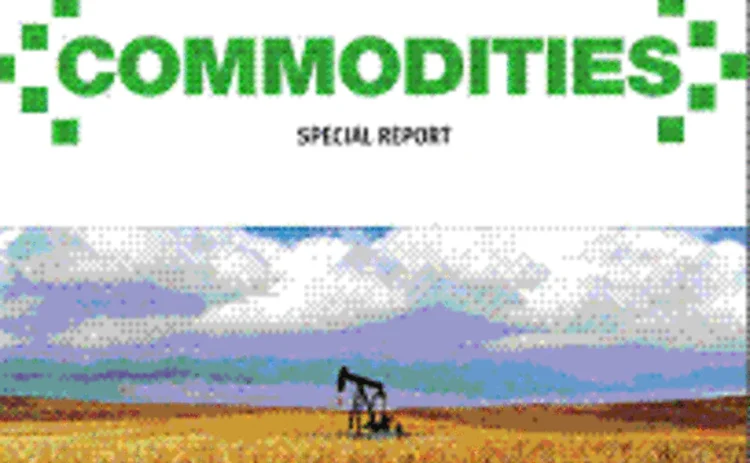Commodities special report

Click here to download the PDF
The Wind of Change... Is Also Data
The commodities markets are in a state of flux. But unlike the changes that have impacted many other asset classes over the past couple of years, commodities are booming, producing a surge in demand for market data on everything from oil and coal to base and precious metals, and crops and livestock, and attracting interest from not just the major commodities trading firms and brokerages, but other speculative traders, hedgers managing risk against related instruments, and even mainstream investors via commodity funds and exchange-traded funds.
But in addition to the usual types of market data required for trading other asset classes-quotes, trades, terms and conditions, maturities, historical information, research, fundamental data, and charting and analytics-commodities also have a range of additional information that must be collected, ranging from crop growth, Department of Agriculture reports, supply and demand data, metrics on the output of individual mines, and weather. And while price data is broadly available from vendors and brokers, more specialized data is frequently the preserve of niche suppliers.
Not only must this data be consolidated together to be useful; it must also be consolidated with other, related information to meet the demands of cross-asset trading strategies as firms arbitrage commodities against each other, or even against other asset classes-trading physical coal or oil against stock in mining or petrochemical companies, for example.
And as these data demands grow, firms will be forced to deal with the same issues that have already been addressed in other asset classes, such as the need for robust data infrastructures that consolidate fragmented sources of increasing volumes of data, and the efficiency arguments of utilizing real-time datafeeds in the back-office as well as on trading desks, to reduce the risk of error from manual processing.
Meanwhile, the Commodity Futures Trading Commission is deciding on setting limits around the level of positions traders can hold in energy and metals futures. Not only does this leave traders uncertain of whether their holdings are compliant or not with the upcoming rules, but also places a burden on the CFTC to collect its own data for the purposes of real-time monitoring of industry positions.
If commodities weren't complicated enough, they're about to reach the next level, and traders and data providers will all need to respond.
Click here to download the PDF
Only users who have a paid subscription or are part of a corporate subscription are able to print or copy content.
To access these options, along with all other subscription benefits, please contact info@waterstechnology.com or view our subscription options here: http://subscriptions.waterstechnology.com/subscribe
You are currently unable to print this content. Please contact info@waterstechnology.com to find out more.
You are currently unable to copy this content. Please contact info@waterstechnology.com to find out more.
Copyright Infopro Digital Limited. All rights reserved.
You may share this content using our article tools. Printing this content is for the sole use of the Authorised User (named subscriber), as outlined in our terms and conditions - https://www.infopro-insight.com/terms-conditions/insight-subscriptions/
If you would like to purchase additional rights please email info@waterstechnology.com
Copyright Infopro Digital Limited. All rights reserved.
You may share this content using our article tools. Copying this content is for the sole use of the Authorised User (named subscriber), as outlined in our terms and conditions - https://www.infopro-insight.com/terms-conditions/insight-subscriptions/
If you would like to purchase additional rights please email info@waterstechnology.com
More on Data Management
Symphony boosts Cloud9 voice offerings with AI
The messaging and collaboration platform builds on Cloud9’s capabilities as it embraces the AI wave in what CEO Brad Levy calls “incremental” steps.
MSCI counts the cost of bank M&A, looks ahead to custom indexes, AI
Cancellations of overlapping contracts following a bank merger put a dent in MSCI’s earnings, but management remains upbeat about the potential of recent acquisitions and new technology developments.
Nasdaq reshuffles tech divisions post-Adenza
Adenza is now fully integrated into the exchange operator’s ecosystem, bringing opportunities for new business and a fresh perspective on how fintech fits into its strategy.
This Week: HKEx's new derivatives platform; GoldenSource; Quonian-SimCorp, and more
A summary of some of the latest financial technology news.
Chris Edmonds takes the reins at ICE Fixed Income and Data Services
Edmonds is now leading ICE’s fixed income and data business as the rush to provide better data and analytics in fixed income builds.
Deutsche Börse democratizes data with Marketplace offering
Deutsche Börse Group is set to unveil its Marketplace, a one-stop data shop designed to simplify and streamline data acquisition and consumption for its clients, while also surfacing data from across the firm to its own users. Jan Stiebing and Sven…
DSB says industry is ready to meet UPI mandate ahead of deadline
The Unique Product Identifier will be required for certain OTC derivatives in the EU at the end of April, following US adoption in January.
Mapping a successful data journey: strategy, execution and sustainability
A well-planned data journey can positively impact an organization’s long-term trajectory. However, it is important to have clarity not only in the strategy but also in successful execution and sustainability for the long haul, argues data veteran Subbiah Subramanian.
Most read
- Chris Edmonds takes the reins at ICE Fixed Income and Data Services
- Deutsche Börse democratizes data with Marketplace offering
- Waters Wavelength Podcast: Broadridge’s Joseph Lo on GPTs








